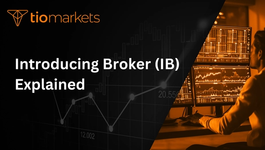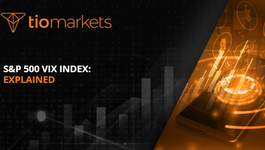A (credit rating): Explained | TIOmarkets
BY TIOmarkets
|June 28, 2024In the world of finance and trading, credit ratings play a pivotal role in determining the creditworthiness of an entity. One such credit rating is 'A', a high-grade rating assigned by credit rating agencies. This article will delve into the intricacies of the 'A' credit rating, its implications for traders, and its role in the broader financial landscape.
Understanding credit ratings, especially the 'A' rating, is crucial for traders. It can impact investment decisions, risk management strategies, and the overall financial health of a trading portfolio. This comprehensive guide will demystify the 'A' credit rating, providing you with the knowledge you need to navigate the complex world of trading.
Understanding Credit Ratings
Credit ratings are essentially an assessment of the creditworthiness of a borrower. They are used by investors to gauge the likelihood of a borrower defaulting on its debt obligations. The ratings are typically assigned by credit rating agencies, such as Standard & Poor's, Moody's, and Fitch Ratings.
The 'A' credit rating is one of the highest ratings a borrower can receive. It signifies a low credit risk, meaning the borrower is likely to fulfill its debt obligations. However, it's important to note that while an 'A' rating indicates a high level of creditworthiness, it is not the highest possible rating.
Components of Credit Ratings
Credit ratings are determined based on a variety of factors. These include the borrower's financial health, its ability to generate income, its existing debt levels, and its history of debt repayment. Other factors, such as economic conditions and the borrower's industry, can also influence credit ratings.
When assigning an 'A' credit rating, agencies look for a strong capacity to meet financial commitments, but the rating may be more susceptible to adverse economic conditions compared to higher ratings.
Understanding the 'A' Credit Rating
The 'A' credit rating is a high-grade rating, indicating a low credit risk. However, it's important to understand that within the 'A' rating, there are sub-categories. These include 'AA' and 'AAA', with 'AAA' being the highest possible rating.
Each of these sub-categories provides further insight into the borrower's creditworthiness. For instance, an 'AA' rating indicates a very low credit risk, while an 'AAA' rating signifies an extremely low credit risk.
Implications for Traders
For traders, understanding credit ratings, particularly the 'A' rating, is crucial. These ratings can impact investment decisions, risk management strategies, and the overall financial health of a trading portfolio.
Investing in entities with an 'A' credit rating can be seen as a relatively safe bet. These entities are likely to fulfill their debt obligations, reducing the risk of losses for the trader. However, it's important to remember that while an 'A' rating indicates a low credit risk, it does not guarantee a risk-free investment.
Investment Decisions
Credit ratings can significantly influence investment decisions. Traders often use these ratings to assess the risk associated with a particular investment. For instance, investing in a company with an 'A' rating may be seen as less risky compared to investing in a company with a lower rating.
However, it's important to remember that credit ratings are just one factor to consider when making investment decisions. Other factors, such as the company's financial performance, industry trends, and economic conditions, should also be taken into account.
Risk Management
Credit ratings can also play a key role in risk management. By investing in entities with high credit ratings, traders can potentially reduce the risk of losses. This is because these entities are less likely to default on their debt obligations.
However, it's important to remember that even entities with an 'A' rating can face financial difficulties. Therefore, traders should always diversify their portfolios to mitigate risks.
The Role of Credit Rating Agencies
Credit rating agencies play a crucial role in the financial markets. They provide investors and traders with an independent assessment of the creditworthiness of a borrower. This information can be invaluable when making investment decisions.
However, it's important to remember that while credit rating agencies strive to provide accurate and unbiased ratings, their assessments are not infallible. Therefore, traders should use credit ratings as one tool among many when assessing the risk associated with a particular investment.
Standard & Poor's, Moody's, and Fitch Ratings
Three of the most well-known credit rating agencies are Standard & Poor's, Moody's, and Fitch Ratings. Each of these agencies has its own methodology for assigning credit ratings, but they all use similar scales.
For instance, all three agencies use the 'A' rating to signify a low credit risk. However, the specific definitions and implications of this rating can vary slightly between agencies.
Criticisms of Credit Rating Agencies
While credit rating agencies play a crucial role in the financial markets, they have faced criticism over the years. Some critics argue that these agencies have too much power, as their ratings can significantly impact the financial markets.
Others argue that the agencies' methodologies are not transparent enough, making it difficult for investors and traders to understand how ratings are determined. Despite these criticisms, credit rating agencies remain a key part of the financial landscape.
Conclusion
Understanding the 'A' credit rating and its implications for traders is crucial. This rating signifies a low credit risk, making it a key factor to consider when making investment decisions and managing risk.
However, it's important to remember that credit ratings are just one tool among many. Traders should always consider a variety of factors when assessing the risk associated with a particular investment.
Start Trading with Confidence at TIOmarkets
Now that you're equipped with the knowledge of 'A' credit ratings, elevate your trading experience with TIOmarkets, a top rated forex broker trusted by over 170,000 clients across 170 countries. Dive into the world of trading with our extensive range of 300+ instruments across 5 markets, all with low fees. Enhance your skills further with our comprehensive educational resources and step-by-step guides. Ready to trade with assurance? Create a Trading Account today and join the ranks of successful traders at TIOmarkets.

Risk disclaimer: CFDs are complex instruments and come with a high risk of losing money rapidly due to leverage. You should consider whether you understand how CFDs work and whether you can afford to take the high risk of losing your money. Never deposit more than you are prepared to lose. Professional client’s losses can exceed their deposit. Please see our risk warning policy and seek independent professional advice if you do not fully understand. This information is not directed or intended for distribution to or use by residents of certain countries/jurisdictions including, but not limited to, USA & OFAC. The Company holds the right to alter the aforementioned list of countries at its own discretion.
Join us on social media

Behind every blog post lies the combined experience of the people working at TIOmarkets. We are a team of dedicated industry professionals and financial markets enthusiasts committed to providing you with trading education and financial markets commentary. Our goal is to help empower you with the knowledge you need to trade in the markets effectively.





